2015 MERCEDES-BENZ SLS AMG GT COUPE seats
[x] Cancel search: seatsPage 5 of 290

Index
....................................................... 4Introduction
......................................... 18 At
ag lance ........................................... 25 Safety
................................................... 35 Opening and closing
...........................61 Seats
,steering wheel and mirrors ....83 Lights and windshield wipers
............95 Climat
econtrol ................................. 105 Driving and parking
..........................117 On-boar
dcomputer and displays ....149 Stowage and features
......................199 Maintenance and care
......................217 Breakdown assistance
.....................233 Wheels and tires
............................... 249 Technica
ldata ................................... 279 Contents
3
Page 14 of 290
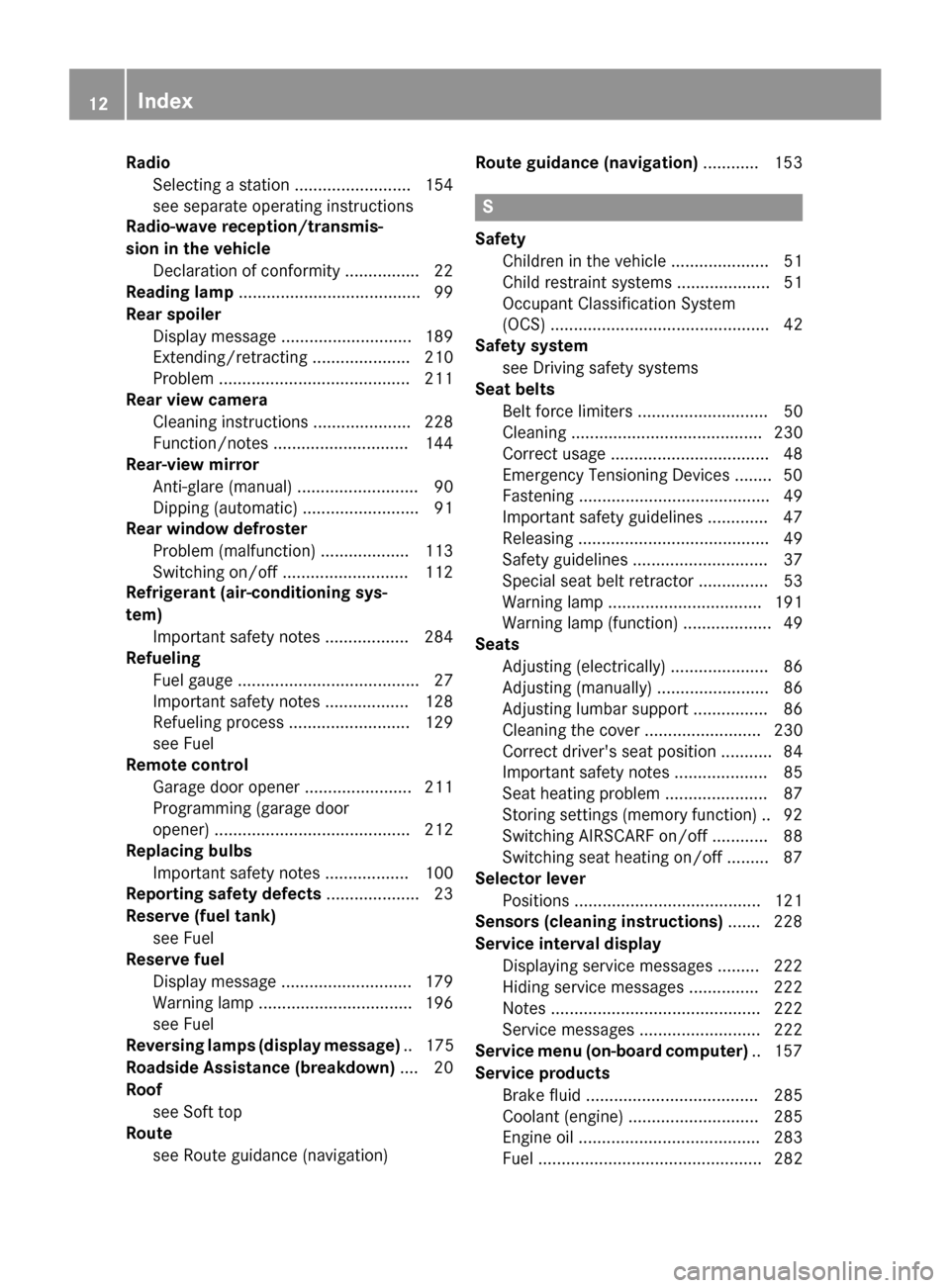
Radio
Selecting astation ......................... 154
see separate operating instructions
Radio-wav ereception/transmis-
sion in the vehicle Declaration of conformity ................ 22
Reading lamp ....................................... 99
Rear spoiler Displa ymessag e............................ 189
Extending/retracting ..................... 210
Problem ......................................... 211
Rear vie wcamera
Cleaning instructions ..................... 228
Function/note s............................. 144
Rear-vie wmirror
Anti-glare (manual) .......................... 90
Dipping (automatic) ......................... 91
Rear windo wdefroster
Problem (malfunction) ................... 113
Switching on/of f........................... 112
Refrigerant (air-conditioning sys-
tem) Important safety notes .................. 284
Refueling
Fuelgauge ....................................... 27
Important safety notes .................. 128
Refueling process .......................... 129
see Fuel
Remote control
Garag edooro pener ....................... 211
Programming (garage door
opener) .......................................... 212
Replacing bulbs
Important safety notes .................. 100
Reporting safety defects .................... 23
Reserve (fuel tank) see Fuel
Reserve fuel
Displa ymessage ............................ 179
Warning lamp ................................. 196
see Fuel
Reversin glamps (display message) .. 175
Roadside Assistance (breakdown) .... 20
Roof see Soft top
Route
see Route guidance (navigation) Route guidanc
e(navigation) ............ 153 S
Safety Childre ninthe vehicl e..................... 51
Chil drestraint systems .................... 51
Occupant Classification System
(OCS) ............................................... 42
Safety system
see Driving safety systems
Seat belts
Beltforce limiters ............................ 50
Cleaning ......................................... 230
Correct usag e.................................. 48
Emergency Tensioning Devices ........ 50
Fastening ......................................... 49
Important safety guideline s............. 47
Releasing ......................................... 49
Safety guideline s............................. 37
Specia lsea tb eltr etractor ............... 53
Warning lamp ................................. 191
Warning lamp (function) ................... 49
Seats
Adjusting (electrically) ..................... 86
Adjusting (manually) ........................ 86
Adjusting lumba rsuppo rt ................ 86
Cleaning the cove r......................... 230
Correct driver' sseatp osition ........... 84
Important safety notes .................... 85
Sea theating problem ...................... 87
Storing settings (memory function) .. 92 Switching AIRSCAR Fon/of f............ 88
Switching sea theating on/of f......... 87
Selecto rlever
Positions ........................................ 121
Sensors (cleaning instructions) ....... 228
Servic einterva ldisplay
Displaying service messages ......... 222
Hiding service messages ............... 222
Note s............................................. 222
Service messages .......................... 222
Servic emenu(on -board computer) .. 157
Servic eproducts
Brake fluid ..................................... 285
Coolant (engine) ............................ 285
Engine oi l....................................... 283
Fue l................................................ 282 12
Index
Page 20 of 290
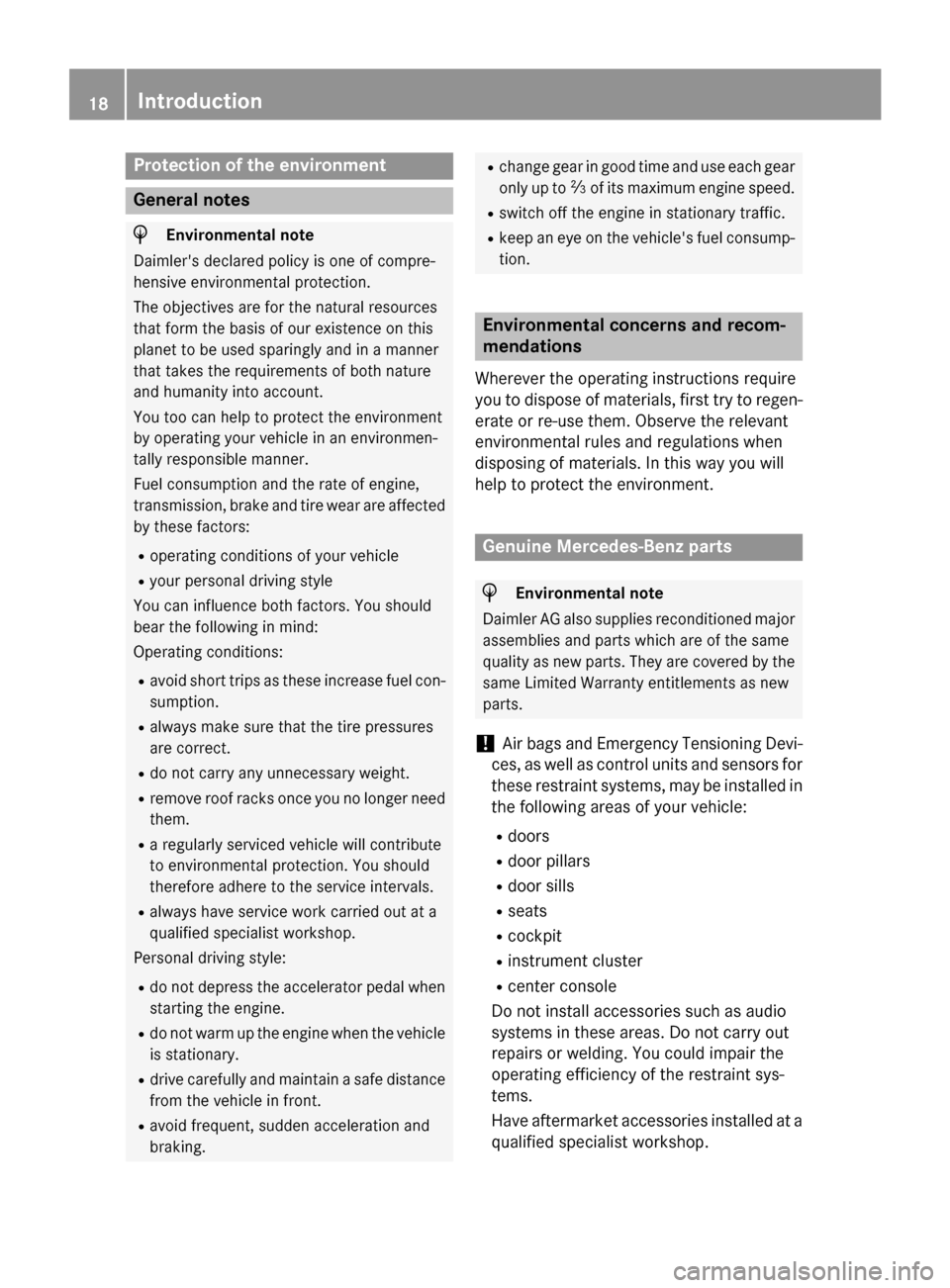
Protection of the environment
General notes
H
Environmental note
Daimler's declared policy is one of compre-
hensive environmental protection.
The objectives are for the natural resources
that form the basis of our existence on this
planet to be used sparingly and in amanner
that takes the requirements of both nature
and humanity into account.
You too can help to protect the environment
by operating your vehicle in an environmen-
tally responsible manner.
Fuel consumption and the rate of engine,
transmission, brake and tire wear are affected by these factors:
R operating condition sofyour vehicle
R your personal driving style
You can influence both factors. You should
bear the following in mind:
Operating conditions:
R avoid short trips as these increase fuel con-
sumption.
R always make sure that the tire pressures
are correct.
R do not carry any unnecessary weight.
R remove roof racks once you no longer need
them.
R ar egularly serviced vehicle will contribute
to environmental protection. You should
therefore adhere to the service intervals.
R always have service work carried out at a
qualified specialist workshop.
Personal driving style:
R do not depress the accelerator pedal when
startingt he engine.
R do not warm up the engine when the vehicle
is stationary.
R drive carefully and maintain asafe distance
from the vehicle in front.
R avoid frequent, sudden acceleration and
braking. R
change gear in good time and use each gear
only up to 00C3of its maximum engine speed.
R switch off the engine in stationary traffic.
R keep an eye on the vehicle's fuel consump-
tion. Environmental concerns and recom-
mendations
Wherever the operating instructions require
you to dispose of materials, first try to regen-
erate or re-use them. Observe the relevant
environmental rules and regulations when
disposing of materials. In this way you will
help to protect the environment. Genuine Mercedes-Benz parts
H
Environmental note
Daimler AG also suppliesr econditioned major
assemblies and parts which are of the same
quality as new parts. They are covered by the same Limited Warranty entitlements as new
parts.
! Air bags and Emergency Tensioning Devi-
ces, as well as control units and sensors for these restraint systems, may be installed inthe following areas of your vehicle:
R doors
R door pillars
R door sills
R seats
R cockpit
R instrumen tcluster
R center console
Do not install accessories such as audio
systems in these areas. Do not carry out
repairs or welding. You could impair the
operating efficienc yofthe restraint sys-
tems.
Have aftermarket accessories installed at a qualified specialist workshop. 18
Introduction
Page 50 of 290

Have al
lworkc arried out only by qualified
technicians. Contact an authorized
Mercedes-Benz Center.
Correct use of the sea tbelts G
WARNING
USE SEAT BELTS PROPERLY
R Seat belts can only wor kwhenu sedp rop-
erly. Neve rwearsea tb elts in any other way
than as described in this section, as that
coul dresult in serious injuries in the event
of an accident.
R Each occupant should wea rthei rseatb elt
at al ltimes ,because sea tbelts hel preduce
the likelihood of and potential severity of
injuries in accidents, including rollovers.
The integrated restraint system includes
SRS (driver front ai rbag,k nee bags, front-
passenger front ai rbag,sidei mpact air
bags, hea dairbags) ,Emergency Tension-
ing Device s(ETDs) and sea tbeltf orce lim-
iters .The system is designe dtoenhance
the protection offered to properl ybelted
occupants in certai nfrontal (front ai rbags,
knee bags and ETDs) and sid e(side impact
ai rb ags, hea dairbags and ETDs) impacts
which excee dpreset deployment thresh-
olds.
R Neve rwearthe shoulde rbeltu nde ryour
arm, across your neck or off your shoulder. In af rontal crash ,you rb odyw ould move
too far forward .Tha tw ould increase the
chance of hea dand neck injuries. The seat
bel twould also apply too much force to the
rib sora bdomen, which coul dseverely
injure interna lorgans such as your liver or
spleen.
Adjus tthe sea tbeltsot hat the shoulder
sectio nislocated as clos easpossible to
the middle of the shoulde r(it should not
touch the neck).
R Position the la pbelta slow as possible on
your hip sand not across the abdomen. If
the la pbeltisp ositioned across your abdo- men, it coul
dcause serious injuries in a
crash.
R Neve rwears eatb elts over rigi dorbreaka-
ble objects in or on your clothing, such as
eyeglasses, pens, keys etc., as these might
cause injuries.
R Make sur ethe sea tbeltisa lwaysfitted
snugly .Take specia lcare of this whe nwear-
ing loose clothing.
R Neve ruse aseatb eltf or more than one
person at atime. Do not faste naseatb elt
around aperson and anothe rperson or
other objects at the sam etime.
R Seat belts should not be wor ntwisted. In a
crash ,you would not hav ethe ful lwidth of
the sea tbelttod istribute impact forces.
The twisted sea tbelta gainst your body
coul dcause injuries.
R Pregnant women should also always use a
lap-shoulder belt. The la pbeltp ortion
should be positioned as low as possible on the hip stoavoid any possible pressur eon
the abdomen.
R Place the sea tbackrest in apositio nthat is
as uprigh tasp ossible.
R Check your sea tbeltd uring trave ltomake
sur eitisp roperlypositioned.
R Neve rplace your feet on the instrument
panel, dashboard ,oronthe seat. Always
keep both feet on the floo rinfront of the
seat.
R Whe nusing aseatb elttos ecure infant
restraints, toddler restraints, or children in
booster seats, always follow the chil dseat
manufacturer's instructions. G
WARNING
Do not pass sea tbelts over sharp edges. They
coul dtear.
Do not allow the sea tbelttog et caught in the
doo rorint he seatadjustment mechanism.
Thi scoul dd amaget he sea tbelt.
Neve rattemp ttom ake modifications to seat
belts. Thi scoul dimpai rthe effectivenes sof
the sea tbelts. 48
Occupan
tsafetySafety
Page 85 of 290
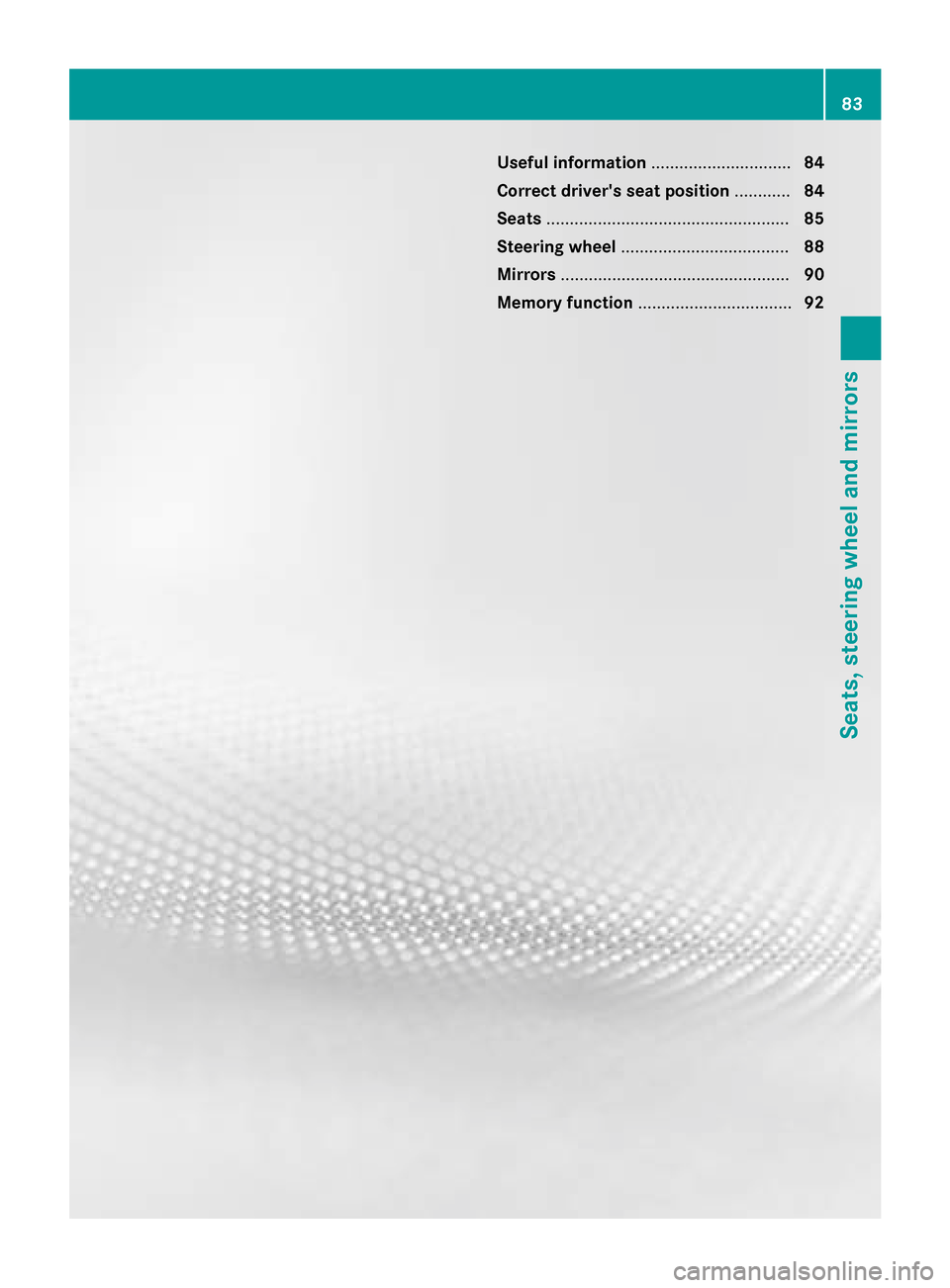
Useful information
..............................84
Correct driver's seat position ............84
Seats .................................................... 85
Steering wheel .................................... 88
Mirrors ................................................. 90
Memor yfunction ................................. 92 83Seats, steering wheel and mirrors
Page 86 of 290
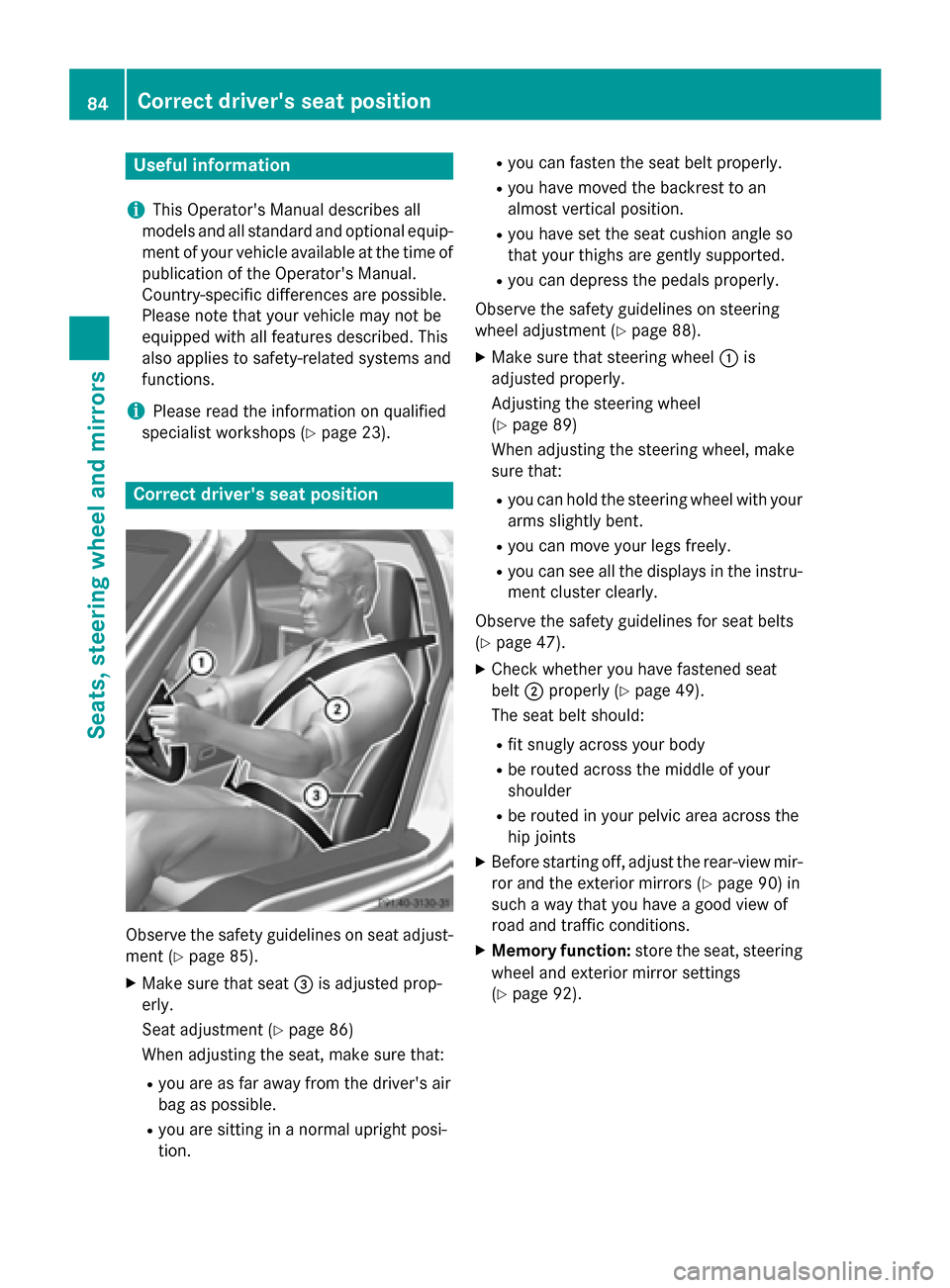
Useful information
i This Operator's Manual describes all
models and all standard and optional equip- ment of your vehicle available at the time of
publication of the Operator's Manual.
Country-specific differences are possible.
Please not ethat your vehicle may not be
equipped with all feature sdescribed. This
also applies to safety-related system sand
functions.
i Please read the information on qualified
specialist workshops (Y page 23).Correct driver's seat position
Observ
ethe safet yguidelines on seat adjust-
ment (Y page 85).
X Make sure that seat 0087is adjusted prop-
erly.
Seat adjustment (Y page 86)
When adjusting the seat, make sure that:
R you are as far away from the driver' sair
bag as possible.
R you are sitting in anormal upright posi-
tion. R
you can faste nthe seat belt properly.
R you have moved the backrest to an
almost vertical position.
R you have set the seat cushion angle so
that your thighs are gently supported.
R you can depress the pedals properly.
Observ ethe safet yguidelines on steering
wheel adjustment (Y page 88).
X Make sure that steering wheel 0043is
adjusted properly.
Adjustin gthe steering wheel
(Y page 89)
When adjusting the steering wheel, make
sure that:
R you can hold the steering wheel with your
arms slightly bent.
R you can move your legs freely.
R you can see all the displays in the instru-
ment cluster clearly.
Observ ethe safet yguidelines for seat belts
(Y page 47).
X Check whether you have fastened seat
belt 0044properly (Y page 49).
The seat belt should:
R fit snugly across your body
R be routed across the middle of your
shoulder
R be routed in your pelvic area across the
hip joints
X Before starting off, adjust the rear-view mir-
ror and the exterior mirrors (Y page 90) in
such away that you have agood view of
road and traffic conditions.
X Memor yfunction: storethe seat, steering
wheel and exterior mirro rsettings
(Y page 92). 84
Correct driver's seat positionSeats, steering wheel and mirrors
Page 87 of 290
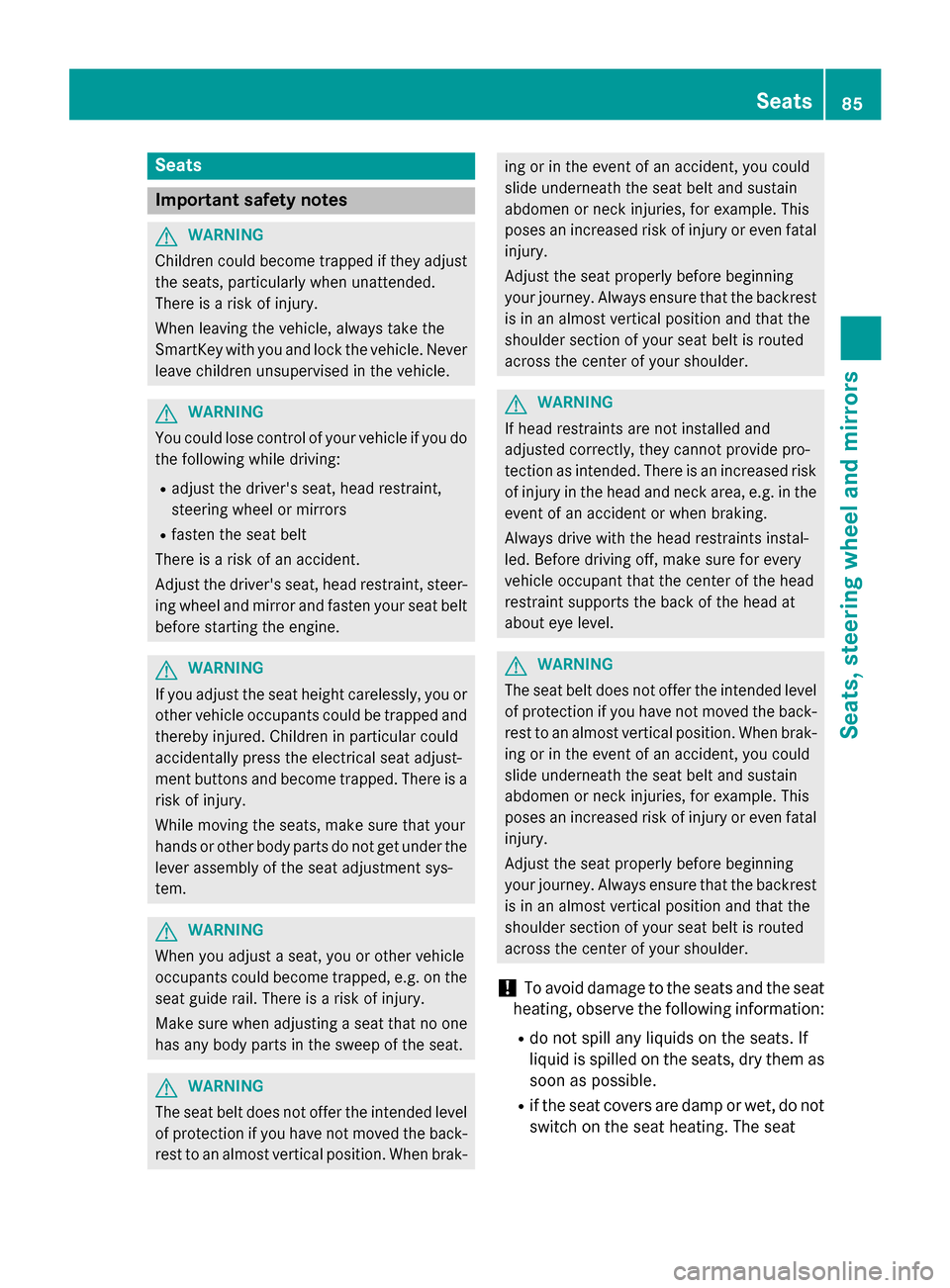
Seats
Important safety notes
G
WARNING
Children could become trapped if they adjust the seats, particularly when unattended.
There is arisk of injury.
When leaving the vehicle, always take the
SmartKey with you and lock the vehicle. Never leave children unsupervised in the vehicle. G
WARNING
You could lose control of your vehicle if you do the following while driving:
R adjust the driver's seat, head restraint,
steering wheel or mirrors
R fasten the seat belt
There is arisk of an accident.
Adjust the driver's seat, head restraint ,steer-
ing wheel and mirror and fasten your seat belt before startingt he engine. G
WARNING
If you adjust the seat height carelessly, you or other vehicle occupants could be trapped andthereby injured. Children in particular could
accidentally press the electrical seat adjust-
ment buttons and become trapped. There is a
risk of injury.
While moving the seats, make sure that your
hands or other body parts do not get under the
lever assembly of the seat adjustment sys-
tem. G
WARNING
When you adjust aseat, you or other vehicle
occupants could become trapped, e.g. on the seat guide rail. There is arisk of injury.
Make sure when adjusting aseat that no one
has any body parts in the sweep of the seat. G
WARNING
The seat belt does not offer the intended level of protection if you have not moved the back-
rest to an almost vertical position. When brak- ing or in the event of an accident, you could
slide underneath the seat belt and sustain
abdomen or neck injuries, for example. This
poses an increased risk of injury or even fatal
injury.
Adjust the seat properly before beginning
your journey. Always ensure that the backrest is in an almost vertical position and that the
shoulder section of your seat belt is routed
across the center of your shoulder. G
WARNING
If head restraint sare not installed and
adjusted correctly, they cannot provide pro-
tection as intended. There is an increased risk
of injury in the head and neck area, e.g. in the event of an accident or when braking.
Always drive with the head restraint sinstal-
led. Before driving off, make sure for every
vehicle occupant that the center of the head
restraint supports the back of the head at
about eye level. G
WARNING
The seat belt does not offer the intended level of protection if you have not moved the back-
rest to an almost vertical position. When brak-
ing or in the event of an accident, you could
slide underneath the seat belt and sustain
abdomen or neck injuries, for example. This
poses an increased risk of injury or even fatal injury.
Adjust the seat properly before beginning
your journey. Always ensure that the backrest
is in an almost vertical position and that the
shoulder section of your seat belt is routed
across the center of your shoulder.
! To avoid damage to the seats and the seat
heating, observe the following information:
R do not spill any liquids on the seats. If
liquidiss pilled on the seats, dry them as
soon as possible.
R if the seat covers are damp or wet, do not
switch on the seat heating. The seat Seats
85Seats, steering wheela nd mirrors Z
Page 88 of 290
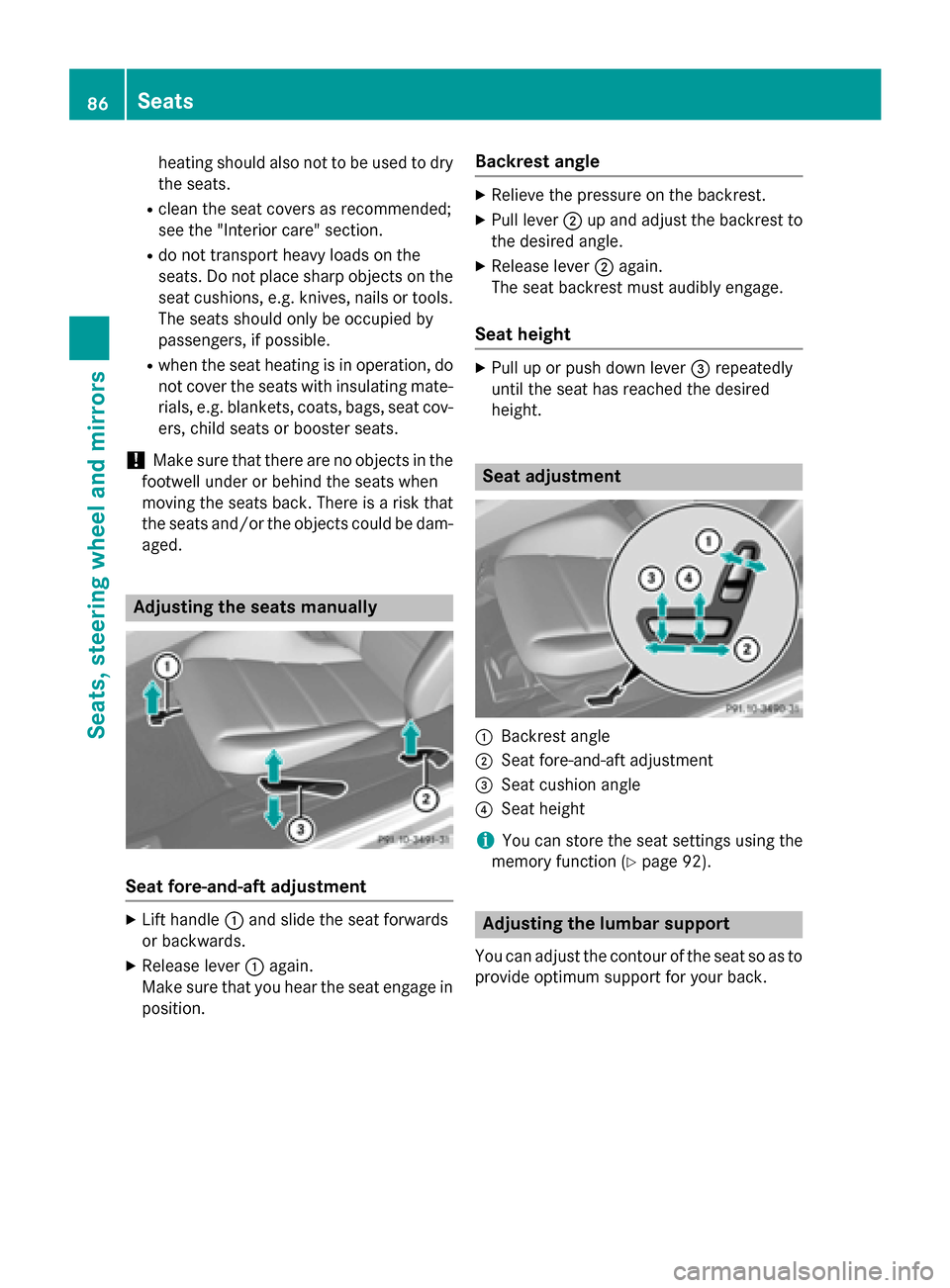
heating should also not to be used to dry
the seats.
R clean the seat covers as recommended;
see the "Interior care" section.
R do not transport heavy loads on the
seats. Do not place sharp objectsont he
seat cushions, e.g. knives, nails or tools. The seats should only be occupied by
passengers, if possible.
R when the seat heating is in operation, do
not cover the seats with insulating mate-
rials, e.g. blankets, coats, bags, seat cov- ers, child seats or booster seats.
! Make sure that there are no objectsint
he
footwell under or behind the seats when
moving the seats back. There is arisk that
the seats and/or the objectsc ould be dam-
aged. Adjusting the seats manually
Seat fore-and-aft adjustment
X
Lift handle 0043and slide the seat forwards
or backwards.
X Release lever 0043again.
Make sure that you hear the seat engage in
position. Backrest angle X
Relieve the pressure on the backrest.
X Pull lever 0044up and adjust the backrest to
the desired angle.
X Release lever 0044again.
The seat backrest must audibly engage.
Seat height X
Pull up or push down lever 0087repeatedly
until the seat has reached the desired
height. Seat adjustment
0043
Backrest angle
0044 Seat fore-and-aft adjustment
0087 Seat cushion angle
0085 Seat height
i You can store the seat settings using the
memory function (Y page 92). Adjusting the lumbar support
You can adjust the contour of the seat so as to
provide optimum support for your back. 86
SeatsSeats, steering wheela
nd mirrors